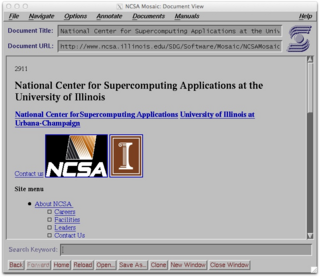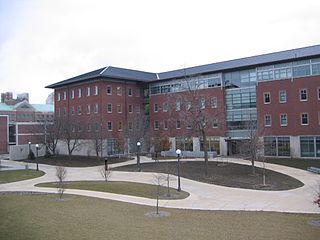Related Research Articles

The Apache HTTP Server is a free and open-source cross-platform web server software, released under the terms of Apache License 2.0. It is developed and maintained by a community of developers under the auspices of the Apache Software Foundation.
In computing, Common Gateway Interface (CGI) is an interface specification that enables web servers to execute an external program to process HTTP or HTTPS user requests.
Netscape Communications Corporation was an American independent computer services company with headquarters in Mountain View, California, and then Dulles, Virginia. Its Netscape web browser was once dominant but lost to Internet Explorer and other competitors in the so-called first browser war, with its market share falling from more than 90 percent in the mid-1990s to less than one percent in 2006. An early Netscape employee Brendan Eich created the JavaScript programming language, the most widely used language for client-side scripting of web pages and a founding engineer of Netscape Lou Montulli created HTTP cookies. The company also developed SSL which was used for securing online communications before its successor TLS took over.

A web server is computer software and underlying hardware that accepts requests via HTTP or its secure variant HTTPS. A user agent, commonly a web browser or web crawler, initiates communication by making a request for a web page or other resource using HTTP, and the server responds with the content of that resource or an error message. A web server can also accept and store resources sent from the user agent if configured to do so.

NCSA Mosaic is a discontinued web browser, and one of the first to be widely available. It was instrumental in popularizing the World Wide Web and the general Internet by integrating multimedia such as text and graphics. It was named for its support of multiple Internet protocols, such as Hypertext Transfer Protocol, File Transfer Protocol, Network News Transfer Protocol, and Gopher. Its intuitive interface, reliability, personal computer support, and simple installation all contributed to its popularity within the web. Mosaic is the first browser to display images inline with text instead of in a separate window. It is often described as the first graphical web browser, though it was preceded by WorldWideWeb, the lesser-known Erwise, and ViolaWWW.

The National Center for Supercomputing Applications (NCSA) is a state-federal partnership to develop and deploy national-scale cyberinfrastructure that advances research, science and engineering based in the United States. NCSA operates as a unit of the University of Illinois Urbana-Champaign, and provides high-performance computing resources to researchers across the country. Support for NCSA comes from the National Science Foundation, the state of Illinois, the University of Illinois, business and industry partners, and other federal agencies.

Ramanathan V. Guha is the creator of widely used web standards such as RSS, RDF and Schema.org. He is also responsible for products such as Google Custom Search. He was a co-founder of Epinions and Alpiri. He currently works at Google as a Google Fellow.
NCSA HTTPd is an early, now discontinued, web server originally developed at the NCSA at the University of Illinois at Urbana–Champaign by Robert McCool and others. First released in 1993, it was among the earliest web servers developed, following Tim Berners-Lee's CERN httpd, Tony Sanders' Plexus server, and some others. It was for some time the natural counterpart to the Mosaic web browser in the client–server World Wide Web. It also introduced the Common Gateway Interface, allowing for the creation of dynamic websites.
Spyglass, Inc. was an Internet software company. It was founded in 1990, in Champaign, Illinois, as an offshoot of the University of Illinois at Urbana–Champaign, and later moved to Naperville, Illinois. Spyglass was created to commercialize and support technologies from the National Center for Supercomputing Applications (NCSA). It focused on data visualization tools, such as graphing packages and 3D rendering engines.
In computer networking davfs2 is a Linux tool for connecting to WebDAV shares as though they were local disks. It is an open-source GPL-licensed file system for mounting WebDAV servers. It uses the FUSE file system API to communicate with the kernel and the neon WebDAV library for communicating with the web server.
Web server software allows computers to act as web servers. The first web servers supported only static files, such as HTML, but now they commonly allow embedding of server side applications.

The World Wide Web is a global information medium that users can access via computers connected to the Internet. The term is often mistakenly used as a synonym for the Internet, but the Web is a service that operates over the Internet, just as email and Usenet do. The history of the Internet and the history of hypertext date back significantly further than that of the World Wide Web.
For computer log management, the Common Log Format, also known as the NCSA Common log format, is a standardized text file format used by web servers when generating server log files. Because the format is standardized, the files can be readily analyzed by a variety of web analysis programs, for example Webalizer and Analog.
The Netscape Server Application Programming Interface (NSAPI) is an application programming interface for extending server software, typically web server software.
A web browser is a software application for retrieving, presenting and traversing information resources on the World Wide Web. It further provides for the capture or input of information which may be returned to the presenting system, then stored or processed as necessary. The method of accessing a particular page or content is achieved by entering its address, known as a Uniform Resource Identifier or URI. This may be a web page, image, video, or other piece of content. Hyperlinks present in resources enable users easily to navigate their browsers to related resources. A web browser can also be defined as an application software or program designed to enable users to access, retrieve and view documents and other resources on the Internet.

When an HTTP client requests a URL that points to a directory structure instead of an actual web page within the directory structure, the web server will generally serve a default page, which is often referred to as a main or "index" page.
The Semantic Sensor Web (SSW) is a marriage of sensor web and semantic Web technologies. The encoding of sensor descriptions and sensor observation data with Semantic Web languages enables more expressive representation, advanced access, and formal analysis of sensor resources. The SSW annotates sensor data with spatial, temporal, and thematic semantic metadata. This technique builds on current standardization efforts within the Open Geospatial Consortium's Sensor Web Enablement (SWE) and extends them with Semantic Web technologies to provide enhanced descriptions and access to sensor data.
FastCGI is a binary protocol for interfacing interactive programs with a web server. It is a variation on the earlier Common Gateway Interface (CGI). FastCGI's main aim is to reduce the overhead related to interfacing between web server and CGI programs, allowing a server to handle more web page requests per unit of time.

The University of Illinois Department of Computer Science is the academic department encompassing the discipline of computer science at the University of Illinois Urbana-Champaign. According to U.S. News & World Report, both its undergraduate and graduate programs rank in the top five among American universities, and according to Computer Science Open Rankings, the department ranks equally high in placing Ph.D. students in tenure-track positions at top universities and winning best paper awards. The department also ranks in the top two among all universities for faculty submissions to reputable journals and academic conferences, as determined by CSRankings.org. From before its official founding in 1964 to today, the department's faculty members and alumni have contributed to projects including the ORDVAC, PLATO, Mosaic, JavaScript and LLVM, and have founded companies including Siebel Systems, Netscape, Mozilla, PayPal, Yelp, YouTube, and Malwarebytes.
Ari Luotonen is a Finnish software developer and author.
References
- 1 2 "News - Awards - Landing Page - IMSA Alumni". Archived from the original on 2016-03-09.
- ↑ Robert Martin McCool at DBLP Bibliography Server
- ↑ Rob Martin McCool author profile page at the ACM Digital Library
- ↑ Mccool, Rob's publications indexed by the Scopus bibliographic database. (subscription required)
- ↑ Robert McCool publications indexed by Microsoft Academic
- ↑ "NCSA HTTPd Acknowledgements". Archived from the original on 2009-04-16.
- ↑ Robinson, D.; Coar, K. (October 2004). "Acknowledgements". The Common Gateway Interface (CGI) Version 1.1. IETF. p. 32. sec. 10. doi: 10.17487/RFC3875 . RFC 3875.
- ↑ Guha, R.; McCool, R. (August 2003). "TAP: A Semantic Web platform". Comput. Netw. 42 (5): 557–577. doi:10.1016/S1389-1286(03)00225-1.
- ↑ Guha, R.; McCool, R.; Miller, E. (2003). Semantic search. WWW'03. Proceedings of the twelfth international conference on World Wide Web. pp. 700–709. doi:10.1145/775152.775250. ISBN 1-58113-680-3.
- ↑ McCool, R. (2005). "Rethinking the Semantic Web, Part 1". IEEE Internet Computing . 9 (6): 86–88. doi:10.1109/MIC.2005.133. S2CID 195915060.
- ↑ McCool, R. (2006). "Rethinking the semantic Web. Part 2". IEEE Internet Computing . 10 (1): 93–96. doi:10.1109/MIC.2006.18.